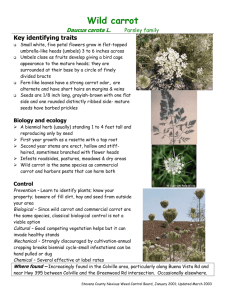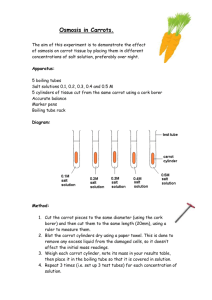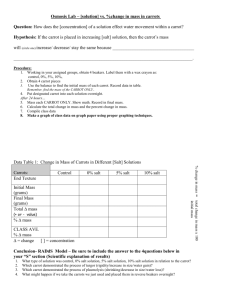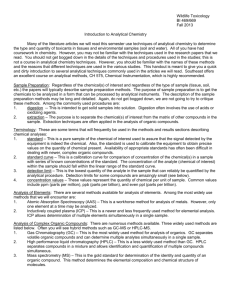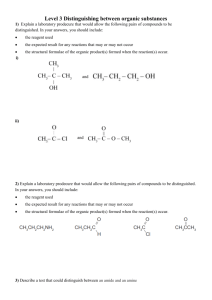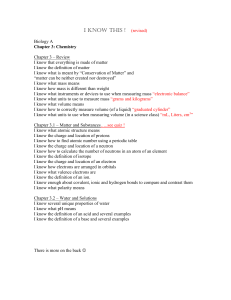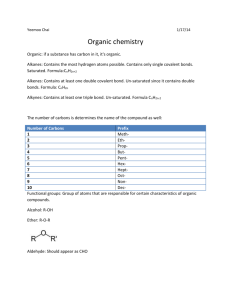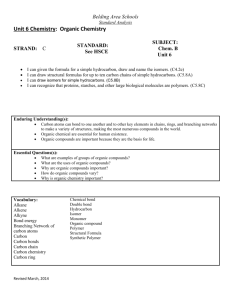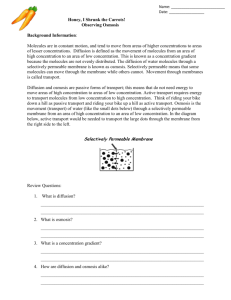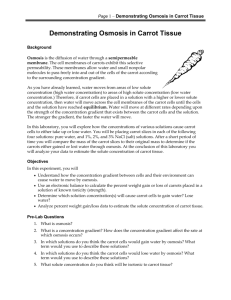Source file
advertisement
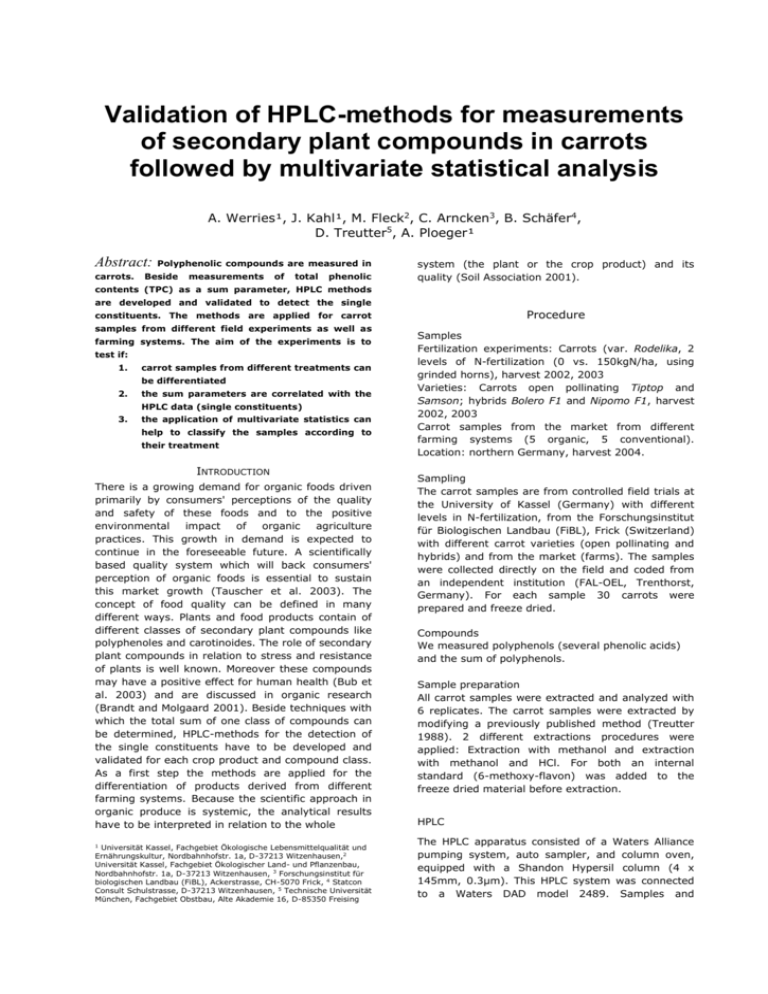
Validation of HPLC-methods for measurements of secondary plant compounds in carrots followed by multivariate statistical analysis A. Werries¹, J. Kahl¹, M. Fleck2, C. Arncken3, B. Schäfer4, D. Treutter5, A. Ploeger¹ Abstract: Polyphenolic compounds are measured in carrots. Beside measurements of total phenolic system (the plant or the crop product) and its quality (Soil Association 2001). contents (TPC) as a sum parameter, HPLC methods are developed and validated to detect the single Procedure constituents. The methods are applied for carrot samples from different field experiments as well as farming systems. The aim of the experiments is to test if: 1. carrot samples from different treatments can be differentiated 2. the sum parameters are correlated with the HPLC data (single constituents) 3. the application of multivariate statistics can help to classify the samples according to their treatment INTRODUCTION There is a growing demand for organic foods driven primarily by consumers' perceptions of the quality and safety of these foods and to the positive environmental impact of organic agriculture practices. This growth in demand is expected to continue in the foreseeable future. A scientifically based quality system which will back consumers' perception of organic foods is essential to sustain this market growth (Tauscher et al. 2003). The concept of food quality can be defined in many different ways. Plants and food products contain of different classes of secondary plant compounds like polyphenoles and carotinoides. The role of secondary plant compounds in relation to stress and resistance of plants is well known. Moreover these compounds may have a positive effect for human health (Bub et al. 2003) and are discussed in organic research (Brandt and Molgaard 2001). Beside techniques with which the total sum of one class of compounds can be determined, HPLC-methods for the detection of the single constituents have to be developed and validated for each crop product and compound class. As a first step the methods are applied for the differentiation of products derived from different farming systems. Because the scientific approach in organic produce is systemic, the analytical results have to be interpreted in relation to the whole Universität Kassel, Fachgebiet Ökologische Lebensmittelqualität und Ernährungskultur, Nordbahnhofstr. 1a, D-37213 Witzenhausen,2 Universität Kassel, Fachgebiet Ökologischer Land- und Pflanzenbau, Nordbahnhofstr. 1a, D-37213 Witzenhausen, 3 Forschungsinstitut für biologischen Landbau (FiBL), Ackerstrasse, CH-5070 Frick, 4 Statcon Consult Schulstrasse, D-37213 Witzenhausen, 5 Technische Universität München, Fachgebiet Obstbau, Alte Akademie 16, D-85350 Freising 1 Samples Fertilization experiments: Carrots (var. Rodelika, 2 levels of N-fertilization (0 vs. 150kgN/ha, using grinded horns), harvest 2002, 2003 Varieties: Carrots open pollinating Tiptop and Samson; hybrids Bolero F1 and Nipomo F1, harvest 2002, 2003 Carrot samples from the market from different farming systems (5 organic, 5 conventional). Location: northern Germany, harvest 2004. Sampling The carrot samples are from controlled field trials at the University of Kassel (Germany) with different levels in N-fertilization, from the Forschungsinstitut für Biologischen Landbau (FiBL), Frick (Switzerland) with different carrot varieties (open pollinating and hybrids) and from the market (farms). The samples were collected directly on the field and coded from an independent institution (FAL-OEL, Trenthorst, Germany). For each sample 30 carrots were prepared and freeze dried. Compounds We measured polyphenols (several phenolic acids) and the sum of polyphenols. Sample preparation All carrot samples were extracted and analyzed with 6 replicates. The carrot samples were extracted by modifying a previously published method (Treutter 1988). 2 different extractions procedures were applied: Extraction with methanol and extraction with methanol and HCl. For both an internal standard (6-methoxy-flavon) was added to the freeze dried material before extraction. HPLC The HPLC apparatus consisted of a Waters Alliance pumping system, auto sampler, and column oven, equipped with a Shandon Hypersil column (4 x 145mm, 0.3µm). This HPLC system was connected to a Waters DAD model 2489. Samples and standards were injected (15µL) and subjected to a gradient elution program, which consisted of 5% acetic acid in water (solution A) and 100% methanol (solution B). The DAD was set to monitor 280nm for the polyphenoles. Data were collected and analyzed using Empower software from waters. For the detection of the sum of the polyphenols we used the method Folin-Ciocalteau as described in literature (Singleton et al. 1965). Validation The characterization and validation of the method reflect the general requirements of the competence of testing laboratories (e.g. Kromidas 2000). For validation, specific requirements have to be fulfilled which will be discussed in this contribution. A systematic assessment of the factors influencing the result has to be carried out as one of the criteria for the determination of the performance of the method. Furthermore the method parameters linearity, selectivity and repeatability shall be determined. Based on validated single methods, multivariate statistics can be applied in order to classify the different samples. Results and Conclusions Methods were developed and applied for the detection of single polyphenols in carrot samples. The procedures for sample preparation and separation were developed by modifying previously published methods and subsequently validated successfully for the differentiation of samples derived from different treatments. For validation not only the method parameters linearity, selectivity and repeatability were determined but also the important factors of influence were investigated. and quantified. P-hydroxybenzoic acid and chlorogenic acid were identified using standard substances (retention time and UV-spectra). Caffeic acid and chlorogenic acid derivates were identified by applying the HPLC solution of each peak in thin layer chromatography. The samples can be differentiated as statistical significant on the basis of selected single compounds. The differentiation ability depends on the compound class as well as the single compound. For classification of the different treatments several multivariate statistical methods (Linear discriminant analysis, LDA; Cluster analysis and Classification and Regression Tree (CART) were successfully applied. ACKNOWLEDGEMENTS Part of the work was supported from the BMVEL (Bundesprogramm Ökolandbau). The authors thank Dr. G. Rahmann (FAL-OEL) for coding and distributing the samples. REFERENCES Brandt K., Molgaard J.P. (2001) Organic Agriculture: does it enhance or reduce the nutritional value of plant foods? J. Sci. Food Agric., 81, 924-931. Bub A., Watzl B., Blockhaus M., Briviba K., Liegibel U. M., Müller H., Pool-Zobel B.L., Rechkemmer G. (2003) Fruit juice consumption modulates antioxidative status and immune status and DNA damage, Journal of Nutritional Biochemistry, 14, 9098. Kromidas S. (Ed.) (2000) Handbuch Validierung in der Analytik, Wiley-VCH, Weinheim. Soil Association (Ed.) (2001) Organic Farming, food quality and human health, Soil Association, Bristol. Figure 1: Canonical plot from LDA with carrot samples from the market with peaks no. 4, 5, 6 and 8 as discriminant scores (letters: locations; numbers: farming systems) R2 15 Singleton V.L., Rossi J.A. (1965) Colorimetry of total phenolics with phosphomolibdic-phophotungstic acid reagent, Am. J. Enol. Vitic., 37, 144-148. 5 Tauscher B., Brack G., Flachowsky G., Henning M., Köpke, U., Meier-Ploeger A., Münzing K., Niggli U., Pabst K., Rahmann G., Willhöft C., Meyer-Miebach E. (2003) Bewertung von Lebensmitteln verschiedener Produktionsverfahren. Statusbericht 2003. Senatsarbeitsgruppe “Qualitative Bewertung von Lebensmitteln aus alternativer und konventioneller Produktion“. P2 P1 10 -5 RO1 1 S2 Peak Nr. 4 Peak Nr. 5 Peak Nr. 9 7 8 Q2 0 Q1 Canonical2 S1 Peak Nr. 6 O2 -10 -15 -20 -50 -40 -30 -20 -10 0 Canonical1 When the validated method was applied on coded carrot samples several polyphenoles (e.g. chlorogenic and caffeic acid derivatives) are detected Treutter D. (1988) Separation of naturally occuring mixtures of phenolic compounds from various Prunus tissues by reversed–phase high performance liquid chromatography, J. Chromatogr. 436, 490496.
